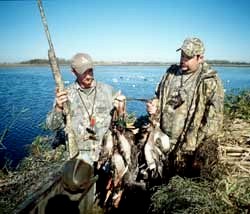
Canvasbacks, Redheads, and Northern Shovelers Break Traditional Survey Records
Preliminary results from the U.S. Fish and Wildlife Service and Canadian Wildlife Service’s Waterfowl Breeding Population and Habitat Survey indicate a total duck population estimate of more than 41 million birds in the traditional survey area.
This represents a 14 percent increase from 2006 and is 24 percent above the 1955-2006 average.
“There’s a lot of good news in the survey this year for the total duck population and waterfowl breeding habitat,” said H. Dale Hall, Director of the U.S. Fish and Wildlife Service. “We have five species that are at record or near record highs, including canvasbacks, and there are good breeding conditions on the prairies. However, we remain concerned that pintails and scaup are well below long-term averages.”
The Waterfowl Breeding Population and Habitat Survey, the largest and most comprehensive survey of its kind in the world, samples 1.3 million square miles across the north- central United States, south-central and northern Canada, and Alaska. The survey estimates the number of ducks in the continent’s most important nesting grounds.
Annual survey results help guide the Service in managing waterfowl conservation programs under authority of the 1918 Migratory Bird Treaty Act. The Service works in partnership with State representatives from the four Flyway Councils – the Atlantic, Mississippi, Central and Pacific – to establish regulatory frameworks for waterfowl hunting season lengths, dates and bag limits.
Overall, habitat conditions for breeding waterfowl in 2007 were similar or slightly improved compared to conditions in 2006. The total pond estimate (Prairie Canada and United States combined) was 7.0 million ponds, 15 percent greater than last year’s estimate of 6.1 million ponds and 44 percent higher than the long-term average of 4.9 million ponds. For the third year in a row, habitat conditions were good or excellent in the northern grasslands and parklands of southern Saskatchewan and southern Manitoba. Conditions in the Eastern Dakotas, which experienced drought in 2006, were improved by abundant fall and winter precipitation, especially in eastern South Dakota.
Highlights from the survey in the north-central United States, south-central and northern Canada, and Alaska include:
· The estimated number of 8.0 million mallards is 10 percent greater than last year’s estimate of 7.3 million birds and 7 percent above the long-term average.
· The estimated number of 6.7 million blue-winged teal is 14 percent greater than last year’s estimate and 48 percent above the long-term average. This year is the third highest estimate on record.
· The estimated number of 2.9 million green-winged teal is similar to last year and 55 percent above the long-term average.
· The estimated number of 3.4 million gadwall is 19 percent greater than last year and 96 percent above the long-term average, and the second highest estimate on record for the traditional survey area.
· The estimated number of 1.0 million redheads is similar to last year and 60 percent above the long-term average. This is a record high for the traditional survey area.
· The estimated number of 865,000 canvasbacks is similar to last year and 53 percent above the long-term average. This is a record high for the traditional survey area.
· The estimated number of northern shovelers at 4.6 million birds is 24 percent above last year and 106 percent above the long-term average. This is a record high for the traditional survey area.
· The estimated number of American wigeon at 2.8 million birds is 29 percent greater than last year and similar to the long term average for this species.
· The estimated number of scaup (lesser and greater combined) at 3.5 million birds, similar to last year and 33 percent below the long-term average. This is the third lowest scaup estimate on record for the traditional survey area. The 2007 estimate for scaup was greater than in 2006; however, this increase was not statistically significant.
· The abundance of northern pintails at 3.3 million birds is similar to last year and 19 percent below the 1955-2005 average.
For the eastern survey area — which includes Maine, Maritime Canada, Newfoundland, Labrador, eastern and northern Ontario, and Quebec — estimates for all species were similar to last year. Estimates for American black ducks and ring-necked ducks were significantly above their long-term (1990-2006) averages.
This preliminary report does not include information from surveys conducted by State or Provincial agencies or information on the status of geese and swans. The entire 2007 Trends in Breeding Duck Populations Report is available on the Service’s Web site at < http://www.fws.gov/migratorybirds/>.
The 2007 Waterfowl Status Report will be available at the same site in late July. This report will include information from State and Provincial surveys as well as goose and swan information. Interviews with the pilot/biologists and video of the conditions can be see at <http://www.fws.gov/video/wmv/statusprelim2007a.wmv>
The U.S. Fish and Wildlife Service is the principal Federal agency responsible for conserving, protecting and enhancing fish, wildlife and plants and their habitats for the continuing benefit of the American people. The Service manages the 97-million-acre National Wildlife Refuge System, which encompasses 547 national wildlife refuges, thousands of small wetlands and other special management areas. It also operates 69 national fish hatcheries, 64 fishery resources offices and 81 ecological services field stations. The agency enforces federal wildlife laws, administers the Endangered Species Act, manages migratory bird populations, restores nationally significant fisheries, conserves and restores wildlife habitat such as wetlands, and helps foreign and Native American tribal governments with their conservation efforts. It also oversees the Federal Assistance program, which distributes hundreds of millions of dollars in excise taxes on fishing and hunting equipment to state fish and wildlife agencies.



Be the first to comment